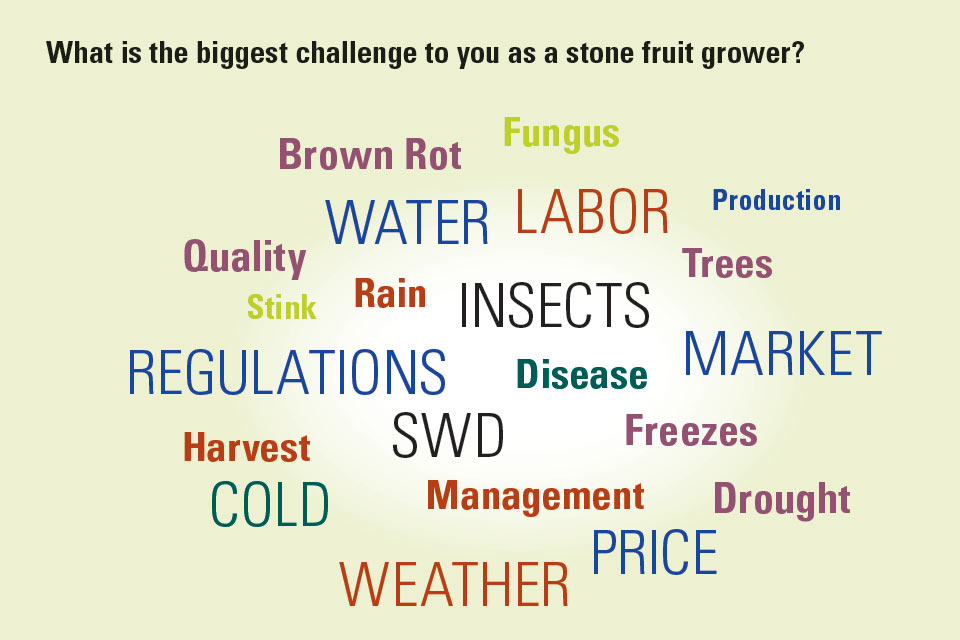State of the Industry: Stone Fruit Growers are Optimistic
As a whole, the nation’s stone fruit growers are really looking forward to 2017.
The results from our State of the Industry survey regarding their production plans for the coming year show growers are brimming with confidence. Fully 43% plan to increase production in 2017, while 49% plan to stay the same. Those results are very similar to 2016 — back-to-back years of positive vibes.
 Only 8% of growers have plans to decrease production. That comes as a bit of a surprise following a year when growers in New England got no love at all after a warm February took a dark turn on Valentine’s Day.
Only 8% of growers have plans to decrease production. That comes as a bit of a surprise following a year when growers in New England got no love at all after a warm February took a dark turn on Valentine’s Day.
Jon Clements, a tree fruit specialist working for University of Massachusetts, Amherst’s Extension Fruit Program Clements, said peach trees were left vulnerable to a sudden drop in temperature.
“When temperatures start to go below -10°F, we typically expect the peach buds to start dying off,” said Clements, a member of American Fruit Grower® and Western Fruit Grower® magazines’ Editorial Advisory Board. “They just aren’t hardy enough for it, which is why we don’t see them growing in the wild.”
One grower answering the survey definitely agreed. A Northeast diversified grower whose farm has been in business more than a century said their biggest challenge growing stone fruit is the weather, and they will decrease production this year.
“I don’t think stone fruits make sense in this area,” the grower concluded.
But, as the survey results show, that grower is definitely in the minority even in the Northeast.

Another Northeast grower with a century farm agreed the weather last year was dreadful. “No stone fruit due to freeze, and small pome fruit crop due to drought,” he said. “Sales were down more than 10%.”
But clearly an optimist, he added that while he was holding steady on stone fruit production, in addition to going up in apples and berries.
Another Northeast grower complained of spring frost and later record high temperatures, along with severe drought. But while sales were down in 2016, he said he had found a way to improve profits: “Fired slow workers.” That goes along with his plans for investment in 2017: Computer services and technology.
One large-acreage grower in the Northeast said she plans on increasing production of stone fruit in 2017 because there’s a great opportunity. “So many growers switching to new high-density apple varieties and pushing out stone fruit,” she said.
Standing Pat
Interestingly, it wasn’t just Northeast growers who complained about weather; several Southeast growers said they sustained freeze damage in 2016.
One said because of freezes, his production was down more than 10%. But he’s not decreasing production because he sees opportunities to sell high-quality fruit to people who want to buy locally.
 “(There is) demand for tree-ripe quality, tasty fruit,” he said. “Do away with bland, red fruit that is horrible.”
“(There is) demand for tree-ripe quality, tasty fruit,” he said. “Do away with bland, red fruit that is horrible.”
Another of the plurality of growers who are staying the same on production in 2017 is one Millennial who farms over more than 2,500 acres. He said it only makes sense to proceed with caution.
“If we can figure out organic stone fruits, I think we will have a market for them,” he said. “Problem is getting a program that works.”
Among the challenges in growing organically, he said, is spotted wing drosophila is starting to move into his area, and trying to control weeds. “We’re starting to use wood chips, which also helps with rodents.”
Ramping Up
Another Northwest cherry grower said he is increasing production in 2017, but not so much because of increasing demand. What does he see as his biggest opportunity for growth?
“Quality of product, as there is not much room for additional markets,” he said. “Therefore, you need a quality product to take a larger piece of the current pie.”
Many of the other stone fruit growers planning to increase production in 2017 are into direct marketing. One Midwest pick-your-own grower said farming organically represents both their greatest opportunity for growth and their biggest challenge, because of disease management.
But the main reason for increasing acreage is “organic production of fruit sold into the Chicago market — where we are one of the only local organic growers.”
A Southeast diversified grower says they are increasing production because they can play to their strength in direct marketing.
“We are good at successive planning, having produce available throughout the entire growing period,” he said.
Their biggest opportunity for growth? “Growing peaches which come off earlier and later than the main varieties grown by other area farmers.”









